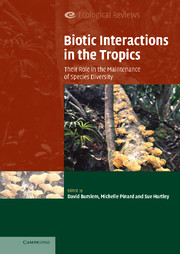Book contents
- Frontmatter
- Contents
- List of contributors
- Preface
- PART I Plant–plant interactions
- 1 Plant–plant interactions in tropical forests
- 2 Resource capture and use by tropical forest tree seedlings and their consequences for competition
- 3 Role of life-history trade-offs in the equalization and differentiation of tropical tree species
- 4 Neighbourhood effects on sapling growth and survival in a neotropical forest and the ecological-equivalence hypothesis
- 5 Ecological drift in niche-structured communities: neutral pattern does not imply neutral process
- PART II Plant–microbe interactions
- PART III Plant–animal interactions
- PART IV Biotic interactions in human-dominated landscapes
- Index
- References
2 - Resource capture and use by tropical forest tree seedlings and their consequences for competition
Published online by Cambridge University Press: 25 August 2009
- Frontmatter
- Contents
- List of contributors
- Preface
- PART I Plant–plant interactions
- 1 Plant–plant interactions in tropical forests
- 2 Resource capture and use by tropical forest tree seedlings and their consequences for competition
- 3 Role of life-history trade-offs in the equalization and differentiation of tropical tree species
- 4 Neighbourhood effects on sapling growth and survival in a neotropical forest and the ecological-equivalence hypothesis
- 5 Ecological drift in niche-structured communities: neutral pattern does not imply neutral process
- PART II Plant–microbe interactions
- PART III Plant–animal interactions
- PART IV Biotic interactions in human-dominated landscapes
- Index
- References
Summary
Introduction
All plants need the same resources (water, light and nutrients) for their survival, growth and reproduction. Paradoxically, water is a limiting resource in many tropical rain forests. Variation in community structure, composition and functioning is driven to a large extent by variation in rainfall (Medina 1999; Poorter et al. 2004). Species composition changes continuously and gradually along the rainfall gradient (Hall & Swaine 1981; Bongers et al. 1999; Bongers et al. 2004), and within forests species tend to sort out along slope gradients in water availability (van Rompaey 1993; Webb & Peart 2000; Harms et al. 2001). Within a given forest a range of species coexist that differ in their drought tolerance. These species face to a greater or lesser extent a bottleneck during the dry season, when water is in short supply. Seasonal droughts (with low soil matric potentials) occur annually in tropical moist forest and occasionally in tropical wet forest (Veenendaal et al. 1996a). Even in seemingly aseasonal wet forests dry periods of 15–30 days may occur every other year (Walsh & Newbery 1999).
Within a certain forest type, variation in canopy openness leads to marked gradients in irradiance, temperature and relative humidity (Brown 1993). The light available in gaps can be as high as 30% of full light, whereas in the understorey it can be as low as 1%. Light is therefore the most limiting resource in many humid tropical forests (Whitmore 1996).
- Type
- Chapter
- Information
- Biotic Interactions in the TropicsTheir Role in the Maintenance of Species Diversity, pp. 35 - 64Publisher: Cambridge University PressPrint publication year: 2005
References
- 31
- Cited by



